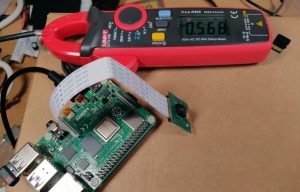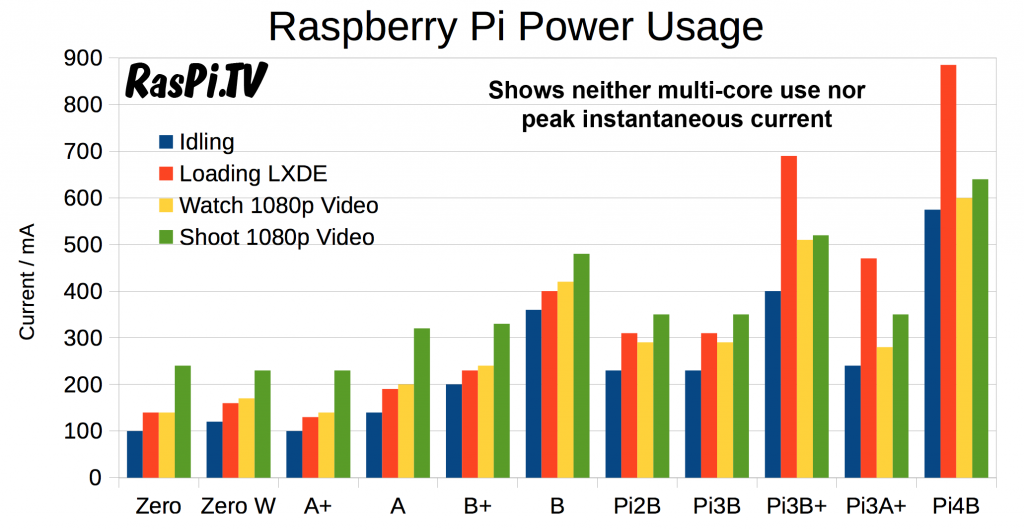
Each time a new Pi comes out, I usually publish some power consumption figures, mainly for those people who want to estimate battery durations. So my tests are quite simple.
Procedure
With just an HDMI screen and a USB keyboard/mouse dongle connected, the Pi current usage was measured using my non-invasive UNI-T clamp meter and a slightly mutilated Anker USB-C lead (to be able to clamp round just the red +ve wire I have to open it up) connected to the Tronsmart 3A power supply I’ve been happily using with my Pi4B. In the past I’ve used my e-Meter AND this clamp meter with a bench PSU and all the readings have agreed closely with each other. This time, rather than destroy TWO USB-C cables I went with just the clamp meter.
Input voltage was 4.965V. When powered down, the Pi4B uses 0.069 Amps.
After zeroing the clamp meter, then clamping around the red wire, current was measured whilst performing four different activities on the latest Raspbian Buster distro…
- Idling
- Loading LXDE (
startx) - Watching a 1080p video on the µSD card with omxplayer
- Shooting 1080p video with a Pi camera 1 (but not recording to µSD card)
The camera module is unplugged for all but the shooting video test. The Pi4B was not connected to wifi, and no bluetooth devices were paired or in use.
Understanding the Limitations
It’s important to understand the limitations of any equipment, tests and results. The UNI-T clamp meter reads to 3 decimal places of an Amp, but it won’t give a true picture of peak instantaneous current e.g. on power-up of the ARM cores from idle. This matters only when selecting a PSU to run your Pi (you already have the official recommendations of a 3.0 Amp PSU for that). What we’re interested in is power usage over time, so you can work out what size battery pack or solar panel you will need for portable applications.
Results
Commentary
The Pi4B has a new, more powerful, processor and GPU. It also has a higher specification for the power supply. It’s now 3A up from 2.5A for the 3B+. So it would be reasonable to expect readings a bit higher than those we get for previous generations of Pi.
- The Pi4B uses 575 mA (2.85 Watts) at idle, both in LXDE and in the command line. This is 175 mA more than the Pi3B+
- Loading LXDE is pretty fast and it peaked at 885 mA. This compares with 690 mA for the 3B+, but is faster on the 4B.
- Watching 1080p video took 600 mA which was only 25 mA above idle. This is an interesting result because the ‘jump’ is less than previous generations of Pi, which required 60-100 mA greater than idle current. It could be something to do with the more compact silicon or the VC6. It could be an error, but I measured it several times and it was consistent, so I’m inclined to trust it.
- Shooting video also exhibited a similar pattern, so I think this is something to do with the new silicon. The Pi4B used 640 mA (65 mA more than idle) to display 1080p video. The Pi3B+ only uses 520 mA to display 1080p video, but that’s 120 mA more than at idle. So, again, the difference is less on the Pi4B but it’s not a free lunch because the baseline level is 175 mA higher to begin with.
Summing Up
Pi4B is more powerful than previous generations of Pi and uses more power as a result (you didn’t see that coming did you?)
It probably isn’t the best choice of device for small, battery-powered, portable applications, but since it’s being pitched as a desktop replacement, that’s also not terribly surprising. At idle it uses about 2.85 Watts. When being thrashed it will use a lot more. Unless you REALLY need the extra processing ‘Oomph’ of Pi4, you’d be better off with a Zero W or a Pi3A+ for portable low-power applications.
But, plugged into the wall and sitting on my desk the Pi4B is a fantastic little beastie!
N.B. These simple tests do not consider multi-core CPU operation.



Excellent article! What about some stress tests to measure and compare CPU power?
Thanks for the info, but … are your values for the 2B and 3B correct? It seems suspicious that they are _identical_ for all four tests.
It’s correct… https://raspi.tv/2016/how-much-power-does-raspberry-pi3b-use-how-fast-is-it-compared-to-pi2b
Can it power an external hard drive such as a Western Digital MyPassport?
It should be able to if you’re using a decent PSU
Thanks once more for doing the power consumption testing! I for one always look for your post after a new model is released to see how much power it uses. I was about to put an old Pi 2 in service as a “server” at home (little bit of file sharing and some network services) to replace an original B, but then figured maybe I should wait and get a 4 for the task. After looking at the increased idle power usage, perhaps the 2 is good enough! I know it’s not a lot, but it adds up over time running 24/7 and doing nothing 99.9+ percent of the time…
I am interested in using the Pi 4B with the HDMIPi display. Is the HDMIPi driver board capable of powering the PI4B (with appropriate cable)? Alternatively, can I power the Pi4B directly and run the driver board from one of the Pi’s USB sockets? Clearly I need to also change the HDMI cable link.
It was specified for the original B/B+ Pi1 which was about an Amp, so not likely.
Excellent as always
Interesting post. I’m seeing power consumption a little higher than your measurements, but this may depend on if you’re booting to a CLI or desktop and what networking you are using. The biggest issue I see with this increased power consumption is the additional heat. Especially if you put this Pi 4 in the official Pi 4 Case, with zero ventilation. Even at idle (given high enough ambient temp) or under light load, the board begins to thermally throttle. I’ve shared my research so far: https://www.martinrowan.co.uk/2019/06/raspberry-pi-4-hot-new-release-too-hot-to-use-enclosed/ if you’re interested.
The Pi2B and Pi3B measurements are identical. Is this a typo?
No. See here https://raspi.tv/2016/how-much-power-does-raspberry-pi3b-use-how-fast-is-it-compared-to-pi2b
Do yoi think that when I connect a 2.5″ hard drive to a raspberry pi, will the 5v 3A power supply be able to power the RPi 4 and the 2.5″ drive?